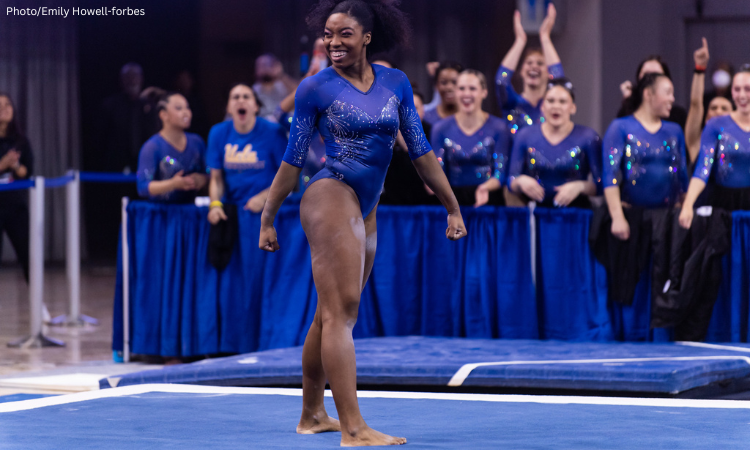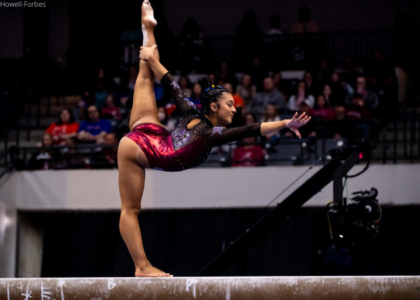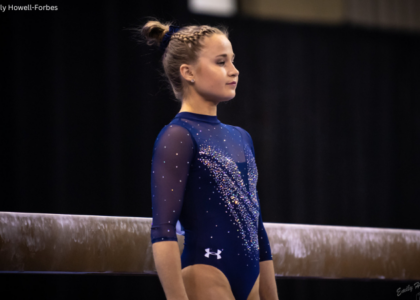NCAA gymnastics is back and better than ever! Last season’s championship broke the one-million viewer mark for the first time, and—with the Olympics following closely after the upcoming season—there are more eyes on the sport than ever before. Just look at ESPN, which recently went all-in on NCAA gym by launching its own invitational meet that will feature four of the sport’s top teams and air on ABC in its prime timeslot.
To aid in new fans’ understanding of our beautiful sport, we have another edition of our how-to guide for following college gymnastics—complete with references to the mainstream sports we all grew up watching. This time around, we’ll be delving into fantasy gymnastics, famous relatives of current or future NCAA gymnasts, and providing you with a Rosetta Stone for gymnastics coverage and terminology.
If you need a refresher course, check out last year’s guide, College Gymnastics 101, and our in-depth breakdown of the NCAA Code of Points.
Fantasy Gym
‘Tis the draft season for fantasy gym fans! Yes, it’s a thing and, yes, we spend just as much time tweaking our weekly lineups as fantasy football players do. While the first online version launched a little over a decade ago, the concept of drafting your favorite gymnasts to a dream team has been around forever. We’ll break down the basics here, but you can always visit online host Gymlytics and CGN’s very own Fantasy Central for more information and to sign up.
The Gist:
- While league rules can vary, most mimic NCAA competition by requiring a player to post five scores on every event .
- Player standings model the NQS system used to determine postseason seeding. Rather than racking up a win-loss record by going head-to-head against different league members each week, the winner of fantasy gymnastics is typically whoever ends up with the highest season average after everyone drops their two lowest weekly scores.
- The number of gymnasts allowed on a roster is determined by the league organizer, but it’s each player’s responsibility to draft enough all-arounders and specialists to have at least five scores on every event each week.
- Fantasy gym leagues tend to give players a bit more leeway than the official six-up/five-count rule used in real NCAA meets by allowing players to put up anywhere from six to 10 gymnasts in each event lineup. The five highest scores per event count toward the player’s weekly total score.
- Even with a 10-up/five-count format, counting zeros happens, and it’s always infuriating (but not nearly as infuriating as someone on your bench scoring a 10.0).
- Trades and the waiver wire exist, but the specific rules vary from league to league.
As with fantasy football, the team name is one of the few aspects of the game wholly within the player’s control. Whether you want to elicit a few chuckles (“Baby Got Pak”) or strike fear into the hearts of your opponents (“The KJ Kindler of This League”), your team name will set the tone for your entire season, so choose wisely…
Need some inspiration? Here are some of our favorites to get you started:
- It Actually Doesn’t Mean More
- Notorious B1G
- Pac-1: Conference of Champion
- Two Howells are Better Than One
- You’ve Got Maile
- Breaux, Do You Even Lift?
- Level 10 Ninjas
- Gymternet Choice: Gabi Stephen’s Dad
- WWKJCD?
Reading Comprehension and Translation
If you can’t watch a meet live, there’s a non-zero chance it’s being live-blogged (especially for high-profile, regular-season meets and postseason match-ups). Even if you have a good baseline knowledge of gymnastics skills and terminology, live blogs can be a tough slog if you aren’t familiar with the various shorthand and abbreviations. Consider this your Rosetta Stone for deciphering gymnastics speak!
A few notes before we get started:
- Abbreviations are transferable across events even if the skills are slightly different (e.g., a front handspring entry vault and a front handspring on beam or floor will all be abbreviated as “FHS”).
- Common skills that are named after a gymnast—like the Omelianchik vault or a Maloney bars transition—are generally just referred to by that name.
- Spelling and capitalization may vary depending on who’s blogging. The number of typos and misidentifications may also vary depending on whether the blogger is watching in person or on television and by how many teams are competing. Live blogging and catching everything is hard!
Common Abbreviations and Jargon
Vault (VT)
- Y: Yurchenko entry plus the number of flips and twists in the flight element; unless otherwise specified, assume the flight is being performed in a laid-out body position
- FTY: Yurchenko full twist; variations include Y full or Y 1/1
- Y 1.5: Yurchenko one and a half twist; variations include Y 3/2
- DTY: Yurchenko double full or double-twisting Yurchenko; variations include Y double full or Y 2/1
- FHS: front handspring entry plus the flight element description (e.g., “FHS pike half” is a front handspring entry and a piked salto with a half twist)
- Y half-on: Yurchenko half turn entry plus the flight element description (e.g., a “Y half-on front pike”)
Bars (UB)
- SBR: same bar release
- KCH: kip, cast, handstand
- VL: van Leeuwen
- FTDT: full-twisting double tuck; variations include full-in or full-out
- DLO: double layout
Beam (BB)
- BHS: back handspring
- Flic: short for flic-flac, an alternate term for a back handspring
- LOSO: layout step-out
- Lay: layout; when referring to a skill performed on beam, usually indicates a layout to two feet versus a layout step-out
Floor (FX)
- Back/front [number with a decimal point or a fraction]: denotes a twisting skill by identifying the direction of the entry and the number of twists (e.g., “RO BHS back 2.5” is “a round-off back handspring into a two and a half twist,” “FHS front 2/1” is “a front handspring into a front double full twist”)
- Rudi: a laid-out front one and a half twist
Other
- AA: all-around
- Arms/legs/knees/feet: generally refers to form issues involving the aforementioned body part (e.g., “BHS LOSO with some knees” is “a back handspring layout step-out with knees slightly bent”)
- CR: composition requirement
- E: execution
- Leg sep: leg separation
- ND: neutral deduction
- OOB: out of bounds
Makes complete sense, right? Once you’ve studied up, here are some live blogs from last season to test your skills and understanding:
2023 Los Angeles Regional Final
2023 Pac-12 Championship Session Two
No. 2 Michigan and No. 18 Georgia
It’s All Relative
Gymnastics requires a ridiculous amount of strength, balance, and coordination, so it’s probably no surprise that a significant number of college gymnasts come from highly athletic families. This is by no means an exhaustive list, just a few of the names we think you’ll recognize.
Baseball
- Two-time World Series champion and future Baseball Hall of Famer Albert Pujols is the father of UC Davis commit Sophia Pujols (2024).
Basketball
- LSU freshman Leah Miller is the daughter of Rhode Island head coach Archie Miller and niece of Sean Miller, the former Arizona head coach now in his second stint leading Xavier.
Football
- Atlanta Falcons tackle Calais Campbell is the uncle of current UCLA star Chae Campbell.
- Jordynn Cromartie of Fisk, the first HBCU to sponsor gymnastics, is the daughter of four-time Pro-Bowler Antonio Cromartie.
- Pittsburgh Steelers head coach Mike Tomlin is the father of four-star recruit Harley Tomlin (2024), who recently signed with Georgia.
- Former Colts quarterback Andrew Luck, the overall number one draft pick in 2012, is married to fellow Stanford alum Nichole Pechanec, who led the Cardinal to two NCAA finals and represented the Czech Republic at three world championships.
Olympics
- Arkansas senior Emma Kelley is the daughter of Mary Lou Retton, the first American gymnast to win a gold medal in the all-around at the Olympics. Her sister, McKenna Kelley, earned All-America honors while competing for LSU.
- Washington sophomore Olivia Oppegard is the niece of Michelle Kwan, who won two Olympic medals in figure skating for the U.S.
Other
- Auburn’s Sara Hubbard is just one of many talented athletes in her family, which includes cousins Cincinnati Bengals defensive end Sam Hubbard and 10-time Olympic swimming medalist Gary Hall Jr., as well as father Bobby Hubbard, a former Big Ten gymnastics champion at Minnesota.
- Cousin to Michigan’s Kaylen Morgan, actor Samuel L. Jackson isn’t technically a famous athlete, but he starred as Coach Carter in one of the most iconic sports movies of all time, so he counts.
READ THIS NEXT: College Gymnastics 102: Another Guide for Mainstream Sports Fans
Article by Claire Billman and Brandis Heffner





2 comments